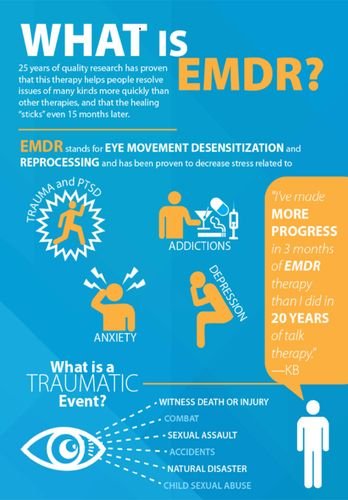How best emdr therapy in nyc promotes emotional strength
Wiki Article
The Refine of EMDR Treatment: a Comprehensive Guide to Its Strategies and Advantages
EMDR treatment attracts attention as an organized method for resolving terrible memories. Its multi-phase strategy and unification of bilateral stimulation techniques set it aside from conventional therapies. By assisting in the reprocessing of distressing experiences, EMDR offers a special path to healing. What certain strategies are used, and what advantages do they offer trauma recovery? Exploring these elements reveals a much deeper understanding of this efficient healing choice.Comprehending EMDR Therapy: A Review
EMDR treatment, or Eye Movement Desensitization and Reprocessing, is a psychiatric therapy technique made to ease the distress related to traumatic memories. Created by Francine Shapiro in the late 1980s, EMDR incorporates components from different restorative techniques, including cognitive-behavioral therapy and psychodynamic therapy. The primary goal of EMDR is to assist people procedure and reframe traumatic memories, decreasing their psychological cost and associated signs.Throughout EMDR sessions, clients take part in double attention stimuli, typically involving directed eye motions, while remembering distressing memories - best emdr therapy in nyc. This process enables the mind to reprocess the memory in a much healthier manner. EMDR has obtained acknowledgment for its efficacy in treating Stress and anxiety, clinical depression, and ptsd, to name a few conditions. Research has revealed that EMDR can lead to substantial improvements in emotional wellness. As an organized treatment, it supplies a detailed framework for specialists to aid clients in overcoming the effect of past injuries
The Eight Phases of EMDR
While many healing methods vary in framework and strategy, the 8 stages of EMDR provide a methodical framework that guides the restorative procedure. These stages start with the history-taking and therapy planning, where the specialist gathers relevant info concerning the customer's experiences and establishes a risk-free atmosphere. The second stage concentrates on prep work, equipping customers with tools to manage psychological distress.In the 3rd stage, customers determine certain memories to target. The 4th stage entails desensitization, where clients process these memories while taking part in bilateral excitement. The fifth stage emphasizes installment, strengthening positive beliefs. The sixth phase addresses body check strategies to determine any kind of recurring stress.
The final two phases involve closure, returning clients to a state of balance, and reevaluation, evaluating the performance of the therapy. This structured approach assurances that EMDR therapy is thorough, attending to both the physiological and emotional facets of trauma.
Secret Techniques Utilized in EMDR Procedure
In EMDR sessions, therapists utilize specific methods to help with recovery and processing of traumatic memories. Secret among these are bilateral stimulation techniques, which involve both hemispheres of the brain, and numerous memory processing methods that assist clients reframe their experiences. Comprehending these techniques is essential for understanding the efficiency of EMDR therapy.Bilateral Excitement Approaches
Bilateral excitement approaches are essential methods employed throughout EMDR sessions to promote the processing of terrible memories. These techniques entail engaging both hemispheres of the mind, advertising combination and recovery. Typical reciprocal excitement techniques include auditory hints, such as alternating audios or tones, and responsive excitement, through the usage of portable devices that develop alternating faucets. Visual stimulations, such as the specialist assisting the client's eye activities back and forth, are also widely used. The rhythmic nature of these strategies assists to activate the mind's natural processing abilities, permitting clients to reprocess traumatic memories in a risk-free setting. Ultimately, reciprocal stimulation fosters a sense of safety and security and enhances the healing experience throughout EMDR.Memory Handling Strategies
Memory processing techniques in EMDR sessions are crucial for aiding clients face and rework traumatic experiences. These methods concentrate on facilitating the reprocessing of upsetting memories, allowing customers to incorporate and deal with negative emotions associated with them. One key approach involves making use of reciprocal excitement, which can include acoustic tones or tactile sensations, to boost the mind's data processing abilities. Throughout sessions, customers are guided to remember specific memories while at the same time involving in reciprocal excitement, promoting a double concentrate on the terrible memory and today minute. This strategy help in lowering the psychological fee of the memory, making it less intrusive. Eventually, memory processing strategies encourage clients to reconstruct their stories, promoting recovery and strength.The Duty of Bilateral Excitement
Reciprocal stimulation is a basic part of EMDR therapy, helping with the processing of traumatic memories. Various methods, such as auditory, responsive, and visual stimulation, are used to involve both hemispheres of the brain. This technique has actually been revealed to enhance injury recovery by promoting emotional guideline and reducing distress linked with past experiences.Device of Bilateral Excitement
When people take part in EMDR therapy, the system of bilateral stimulation plays an important duty in promoting the processing of traumatic memories. This technique involves alternating stimulation, generally via auditory, responsive, or visual means, which activates both hemispheres of the mind. The balanced nature of bilateral excitement is believed to resemble the brain's all-natural handling systems during rapid eye movement, promoting integration of upsetting memories. As customers focus on their distressing experiences while simultaneously taking part in this stimulation, they may experience a decrease in emotional fee linked with those memories. This procedure allows for the reprocessing of injury, leading to enhanced psychological regulation and an extra adaptive perspective on previous occasions.Types of Stimulation Strategies
Numerous excitement methods are made use of in EMDR therapy to enhance the reprocessing of terrible memories. The primary technique is reciprocal stimulation, that includes auditory, aesthetic, and responsive techniques. Auditory stimulation commonly entails rotating sounds played through earphones, while visual excitement can include led eye activities from side to side. Tactile excitement may utilize portable devices that develop alternating taps on the client's hands. Each of these strategies intends to engage both hemispheres of the mind, assisting in a much more effective handling of traumatic memories. Practitioners might choose one or a mix of these techniques based upon customer choices and restorative objectives, making certain a personalized strategy to recovery. These methods are necessary for promoting a deeper combination of stressful experiences within the healing framework.Advantages for Trauma Healing
The role of bilateral stimulation in EMDR therapy considerably contributes to trauma recovery by promoting the processing of distressing memories. This method involves rotating sensory input, commonly via eye motions or acoustic tones, which helps in integrating distressing experiences. By involving both hemispheres check my reference of the brain, reciprocal excitement boosts psychological law and minimizes the intensity of distressing memories. Study suggests that clients frequently experience a decrease in anxiousness and a raised capacity to challenge upsetting ideas. Furthermore, this technique advertises cognitive flexibility, enabling individuals to reframe their experiences in a much more adaptive way. Eventually, the usage of reciprocal stimulation in EMDR treatment plays an important role in enabling individuals to attain enduring healing and resilience in the face of injury.The Science Behind EMDR: How It Works
Although the exact devices of Eye Movement Desensitization and Reprocessing (EMDR) treatment are still being explored, research suggests that it assists in the handling of distressing memories by incorporating sensory, psychological, and cognitive elements. EMDR uses reciprocal excitement, normally via guided eye motions, which is believed to simulate the mind's all-natural processing during rapid eye movement rest. This stimulation might assist customers accessibility and recycle traumatic memories, minimizing their psychological charge.Neuroscientific researches indicate that EMDR may modify the means stressful memories are stored in the mind, promoting adaptive resolution. The therapy motivates individuals to face their memories and connected ideas, allowing them to reframe their experiences. Furthermore, the organized phases of EMDR-- such as setup, history-taking, and desensitization-- support a thorough exploration of the trauma, cultivating assimilation of the fragmented aspects of the memory. This procedure inevitably aims to recover a feeling of balance and emotional health.
Advantages of EMDR for Trauma Healing
EMDR treatment supplies various advantages for individuals recouping from injury, specifically by attending to the emotional and cognitive distortions connected with terrible experiences. One substantial advantage is its capacity to promote rapid processing of stressful memories, commonly causing a decline in signs such as stress and anxiety and clinical depression. This method enables customers to confront their injury in a safe and organized environment, promoting durability and emotional guideline.Additionally, EMDR assists people reframe adverse ideas connected to their trauma, advertising a healthier self-image and restoring a sense of control. The treatment can enhance overall mental health and empower clients to restore their lives, making it a useful tool in injury recovery. In addition, EMDR is suitable for various age and can be adjusted to meet the details needs of individuals, making it a flexible choice for those seeking to heal from their distressing experiences effectively.
That Can Profit From EMDR Treatment?
Individuals from diverse backgrounds and experiences can take advantage of EMDR treatment, particularly those that have come across trauma in numerous types. This includes survivors of youth misuse, natural catastrophes, mishaps, and fight experiences. In addition, individuals struggling with post-traumatic anxiety problem (PTSD) often find EMDR to be an efficient treatment option.Past injury, those handling anxiousness, depression, phobias, and other psychological health conditions may also experience improvements through EMDR. The treatment can assist in dealing with stressful memories that add to these problems.
In addition, EMDR is not limited to adults; teens and children can also benefit, specifically when adjusted to their developmental requirements. On the whole, EMDR treatment provides a functional method, making it suitable for a variety of individuals seeking healing from emotional pain and mental distress. Its structured yet versatile nature permits specialists to tailor the therapy to meet certain customer needs.
Often Asked Concerns
How much time Does an EMDR Treatment Session Typically Last?

Is EMDR Treatment Suitable for Kid?
EMDR therapy can be ideal for youngsters, as it has actually been adjusted to resolve their special developing demands. Properly educated specialists can effectively apply techniques that assist youngsters procedure terrible experiences in an encouraging environment.What Should I Expect After an EMDR Session?
After an EMDR session, people may experience psychological launch, short-term exhaustion, or heightened feelings. Some record boosted clarity and relief, while others could really feel a requirement for added processing time to integrate their experiences effectively.Are There Any Negative Effects of EMDR Therapy?

Just how Do I Discover a Qualified EMDR Therapist?
To discover a qualified EMDR therapist, individuals should look for suggestions from doctor, confirm credentials via expert organizations, and seek advice from on-line directories. Guaranteeing proper training and experience in EMDR is important for efficient treatment.Bilateral excitement is an essential part of EMDR therapy, facilitating the processing of traumatic memories. When people involve in EMDR treatment, the system of bilateral stimulation my sources plays a necessary duty in assisting in the processing of traumatic memories. Various excitement methods are used in EMDR therapy to improve the reprocessing of traumatic memories. The role of bilateral excitement in EMDR treatment substantially adds to injury recovery by facilitating the processing of distressing memories. The specific systems of Eye Motion Desensitization and Reprocessing (EMDR) therapy are still being discovered, research study suggests that it helps with the processing of stressful memories by integrating sensory, psychological, and cognitive elements.
Report this wiki page